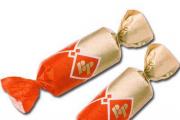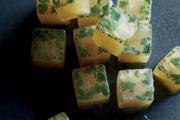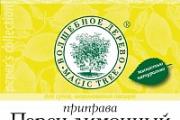Wasabi sauce at home. How to dilute wasabi powder: tips
This is the second time I buy Wasabi Powder from Sen Soi. I like that I can cook it myself, in the consistency I need. The powder is sold in serious packaging: a small, wide-mouth glass jar with a screw cap. All the necessary information is provided on the lid: composition and preparation method.
Cooking method:
1. Mix Wasabi powder with warm water in a ratio of 1: 1.5 based on 1 teaspoon - 1 serving.
2. Stir vigorously to form a thick paste. Let stand for 10 minutes before use, so that the paste dries a little and the strong aroma appears brighter.
Composition: Japanese horseradish powder, mustard powder, synthetic dye (E 133)
By the way, the fact that they sell us this is not real wasabi, this confirms the presence of a dye in the composition of the powder and its low price. Real wasabi is called honwasabi and is much more expensive.
The pungency and pungency of wasabi from Sen Soi is quite enough for me, often the intensity of the taste is different, apparently a lot depends on the method of diluting the powder; but for me wasabi does not play a decisive role, so I do not focus on the method and nuances of its preparation. I dilute it all the time a little differently: now more, then less water, then immediately before eating sushi, then in advance. As a rule, the resulting seasoning suits me perfectly.
I cook wasabi - liquid, because the pasta needs more powder and it seems to me that from a large amount of powder - the seasoning will be too hot. The dilution water should be boiled, but not hot. Recently, I have been breeding wasabi "Frutonyanya baby water", simply because it was at hand: clean and at room temperature. Proportion: 1: 1, a teaspoon of powder and the same amount of water; sometimes there was a little more water.
I don't insist on wasabi for the recommended 10 minutes, but it often happens that I cook it in advance because I use it while making sushi. In many recipes, it is recommended to coat the rice with wasabi before laying out the filling, and it is very convenient to do this with liquid wasabi. I do it either with a spoon or just with my finger. In my opinion, "missed" rolls are tastier than "not missed", the main thing is not to overdo it with wasabi, otherwise it will be too hot and it will be impossible to eat.
But you can influence the taste of wasabi yourself: soften it by adding soy sauce to the powder, or make it spicier by adding rice vinegar. I have not conducted such experiments yet.
In general, I was completely satisfied with wasabi from Sen Soi, both in the way of preparation and the resulting taste. I see no reason not to recommend it to you.
How to dilute wasabi powder to make an authentic Japanese paste. Japanese food lovers are familiar with the pungent wasabi paste that gives such an extraordinary taste to dishes.
The classic paste is made from the dried root of a horseradish-like plant. Real wasabi is very expensive as it grows in mountain running water in a very limited area of Japan. In stores, Japanese horseradish is sold in powder form, which must be diluted with water.
And it often happens that, having tried burning pasta in a good restaurant of Japanese cuisine, an amateur tries to dilute the pasta from the powder on his own, but he gets something completely different.
Alas, most often the method indicated on the powder packaging still does not lead to the desired result. This is due to the fact that the wasabi powder does not contain completely natural wasabi. Due to the high cost of the initial product (the cost of 1 kg of root before drying reaches 15 thousand in rubles), in most cases a powder consisting of mustard powder, dyes and flavors is supplied to retail chains.
In inexpensive restaurants, pasta is prepared from the same powder, so many people do not even suspect that they have never tried real pasta. It is clear that it is possible to breed wasabi from such a powder without any special tricks: you just need to add the same volume of cold water and stir.
It's another matter if you managed to buy powder from natural Japanese horseradish. Such packages are not large in volume, they are expensive and always contain an indication that the contents are made from real raw materials (Real Wasabi or Pure Wasabi). Good brands of powder are often sold in pharmacy-like packages like the famous Namida brand.
In plastic bags, as a rule, a fake mustard powder is sold. High-quality powder from real Japanese horseradish does not have a pronounced green color: this is a sign that either dyes have been added or there are too many leaves in the product, although the classic product is made only from the root.
Therefore, if you managed to buy natural wasabi, then you need to use it as carefully as possible, and here the method of how to dilute Japanese horseradish powder correctly begins to play an important role.

First of all, you shouldn't prepare pasta for future use. It is necessary to dilute as much powder each time as is required for one meal. However, there is no point in storing Japanese horseradish powder for a long time, since volatile substances evaporate and the product loses its unique aroma. Therefore, it is better to buy wasabi powder in small packages.
The second important condition for obtaining a high-quality paste is the use of very cold clean water, preferably ice. The fact is that after drying and grinding the root, all substances are in a sublimated state. When you dilute wasabi powder with water, the substances combine and quickly form a scent.
The icy water slows down this process and gives the paste time to regain its natural taste. Warm water, even at room temperature, separates substances into fractions and some of them volatilize before combining into a whole. Therefore, it is advisable to add ice to the water before diluting the powder and cool it.
So, in order to properly dilute the powder into a paste, you need to follow these steps:
- Prepare a small glass or ceramic bowl.
- Cool clear water with ice.
- Measure out one heaping teaspoon of natural wasabi powder, pour it into a bowl.
- Add one teaspoon of ice cold water.
- Stir quickly until a smooth paste is obtained.
- Cover the bowl with plastic wrap and refrigerate the paste for 5 minutes.
And, of course, the powder itself must be stored in a dark, cold place so that the volatile substances remain intact for a longer time.
It's hard to imagine Japanese cuisine without rice. But it is also impossible to imagine it without a burning greenish additive - wasabi, which is made from the root of the plant of the same name. The process itself is so simple that it is available to everyone at home.
Wasabi powder: it couldn't be easier
For those who live far from Japan, it is difficult to find a fresh root of the plant. However, this is not at all a reason to be upset, because almost every supermarket you can buy wasabi in powder form. As a rule, it is located in the departments where kits and sushi components are sold.
Let's say we have found the right powder. The only thing left to do is to dilute it correctly.
First you need to make sure that the wasabi packaging is completely sealed and free from defects. It is imperative to check the expiration date. Otherwise, the final dish may be disappointing in its taste.
Everything is fine? Let's start cooking. Nothing is needed at all:
Wasabi recipe
- 2 tbsp. l. water;
- one spoonful of prepared wasabi powder
Combine both ingredients in a small bowl and knead well until the mixture reaches the desired consistency. There should be no lumps or residues of dry powder as a result.
Are you planning to serve the additive directly to the table? Fill a small glass with it, wait about 10 minutes and turn over onto a plate. Wasabi will take on an aesthetic shape and look more attractive.
A Few Secrets for Good Wasabi
No matter how much effort is invested in the preparation of wasabi, in rare cases the result is similar to the dish of a master sushi. This is because there are several secrets in the arsenal of professionals, which we will now talk about Use only cold, purified water. Warm water provokes softening processes and wasabi loses its original sharpness;
Use only cold, purified water. Warm water provokes softening processes and wasabi loses its original sharpness;
For a more pungent taste, you can add a little mustard, for a delicate one - mayonnaise;
Stir wasabi best with wooden chopsticks
When choosing utensils for cooking, prefer ceramics or glass;
Do not harvest wasabi "for later", because over time, the additive loses its unique taste.
Did you know? The freshness of wasabi can be easily identified
Slight bitterness indicates that the additive has been prepared for a long time. In turn, a hot mixture is a sign of a fresh product.
You can store ready-made wasabi in the refrigerator, but not for long. Necessarily in glassware with a tight-fitting lid.
Making wasabi for sushi is simple and fun. Feel free to experiment as you rediscover the world of Japanese cuisine
All lovers of Japanese cuisine know what wasabi is. Some even compare it to Russian horseradish. There are indeed some similarities between these spices. Wasabi, like horseradish, is made from the root of the plant of the same name. It grows in the mountains of Japan near rivers and streams. It follows that this plant is not easy to get and the price for it is not cheap. Therefore, wasabi began to be produced in the form of a powder, from which you can make a sauce at home on your own. Now let's take a closer look at how to make wasabi powder.
How to make powder wasabi sauce at home
Buy wasabi powder from the store. Pay attention to the composition. It should include powdered leaves and roots of the wasabi plant, as well as small amounts of additional ingredients. Check the expiration date on the packaging, it is usually 24 months.
To get the familiar ready-made aromatic seasoning from wasabi powder, you need to dilute it with water. For 2 servings of the sauce, you will need one teaspoon of powder and two teaspoons of boiled water. For ease of preparation, you will need regular glasses. Pour powder into one of them and pour water into the other. Then slowly pour the water into a shot glass of wasabi powder, stir the ingredients. You should have a homogeneous mass with a consistency of low-fat 10% sour cream. Transfer the resulting sauce to a plate. To do this, place the glass on a plate, turn it over and knock on top. Then the seasoning will dry out and thicken within 10 minutes. You can mold balls from it, or give it another shape. You can also put the wasabi in a bowl of soy sauce.
Japanese cuisine is hard to imagine without wasabi- seasonings with a unique taste. It is she who gives the somewhat bland dishes of the Land of the Rising Sun an extraordinary spice. European equivalent wasabi horseradish is considered, however, these two plants have nothing in common with each other. Freshly grated wasabi- a huge rarity even for the Japanese, more often than everyone this suitable seasoning is found in the form of a powder. It is usually served with sushi and used in pickles.
You will need
- Wasabi powder;
- water;
- soy sauce;
- sugar;
- rice vinegar.
Instructions
1. Take a glass and pour a teaspoon of powder into it wasabi .
2. Add a little warm water. Many admirers of Japanese cuisine are bred powder only with cold water, considering that the addition of warm water deprives the seasoning of its unique taste. Stir rapidly. You should get a thick paste, reminiscent of clay in consistency.
3. Put a little soy sauce, it is also allowed to add rice vinegar and sugar to the paste to taste. If you add a spoonful of rice vinegar to the powder, the paste will turn out to be sharper. Adding soy sauce will soften the taste much. wasabi... To make the paste more spicy, it is allowed to put grated horseradish.
4. Stir the mixture hefty and scrupulously. There should not be any lumps in it.
5. Drop a glass on a plate, give wasabi stand for 10 minutes: the mixture will dry out a little, and its smell and taste will become much brighter.
6. Place wasabi into a covered gravy boat and serve. Pasta prepared in a similar way can be served with fish, rice, vegetables, sushi.
Fish farming, as usual, is carried out by huge fish farms. But few people know that it is allowed to breed fish even in a small pond, arranged in an ordinary courtyard of a country house or in a country house. And it turns out that there is nothing difficult or strange in the arrangement of such a mini-fish farm.

Instructions
1. Of course, it is unlikely that it will be possible to breed decent fish in a summer pond, but carp and crucian carp are quite unpretentious and charmingly survive in the most modest conditions. They feel very good in shallow, superbly heated reservoirs, non-flowing or possessing a hefty weak flow. For breeding them, a pond with a depth of one meter to one and a half and dimensions of 4 by 6 meters will be absolutely sufficient. In such a pond there will be enough space for several carps, or even for a couple of dozen carps weighing up to 300 grams. When purchasing fish, do not rush to release it into the pond, make sure that the temperature of the water in which the fish is located and the temperature in the pond are the same, a temperature drop of even a couple of degrees will cause a temperature shock in the fish, which is fraught with the permissible death of fish literally during the first day.
2. Crucians and carps are, so to speak, water pigs, in the sense that they are unpretentious in food, and it is allowed to feed them than desirable. Along with protein food (worms and larvae), they are allowed to give cereal food, based on the calculation of 5% of the total weight of fish in the pond. That is, if you have 3 kg of crucians swimming in your pond, then they will need 150 grams of steamed grain or mixed feed per day. Feeding is cooler to make 1-2 times a day at the same time. It is even allowed to hang a small bell by the pond, the fish will swim to its sound and immediately eat the share given to them. They will get used to the routine, the food will be better absorbed, and its remains will not rot, clogging the water. Ideally, for feeding, it is allowed to make a special galvanized pan, and let the feed into the water in it only for the feeding period. This technique will allow you to better control the amount of food eaten and protect the pond from clogging.
3. Make sure that the fish does not become narrow in the pond, if your crucians stick to the surface of the water, gasping for air, then they obviously do not have enough oxygen dissolved in the water. You need to either add water to the pond or reduce the population of your fish farm. Such a dacha fishing industry involves catching each fish from the pond in the fall, your pond is hefty small, in winter it is most likely to freeze, and the fish will die due to lack of oxygen. It may happen that you are not an exclusive angler with a view to your carp. If you notice that a heron or some other fan of eating fresh fish has begun to fly to the pond, then a thin net will have to be pulled over the surface of the pond. Breeding fish in a summer cottage is an interesting business, and by launching the first fish into the pond in April, in August you will be able to start catching them for a light dinner at sunset in August.
Note!
Never dilute wasabi powder for future use, because it does not withstand long storage. Cook only as much as required for your meal. The shelf life of powdered wasabi is virtually unlimited, provided it is stored in a tightly closed container. When the powder is diluted in water, the smell of the seasoning can cause a burning sensation in the mucous membranes of the nose, therefore it is better to protect it with a gauze bandage and not bend low over the container.
Helpful advice
You can choose the consistency of wasabi to your liking. If you want a creamy sauce, easily add a little more water. It is allowed to add a little milk or cream to the sauce - this will make its taste softer. At the moment of mixing, it is allowed to pour in a teaspoon of radish or daikon juice. This will "revive" the properties of the seasoning, and the taste of the finished wasabi from the powder will not differ in any way from the taste of freshly grated wasabi.












